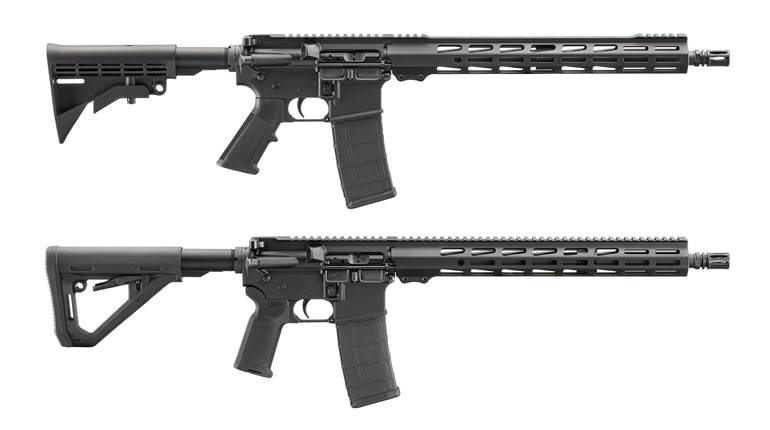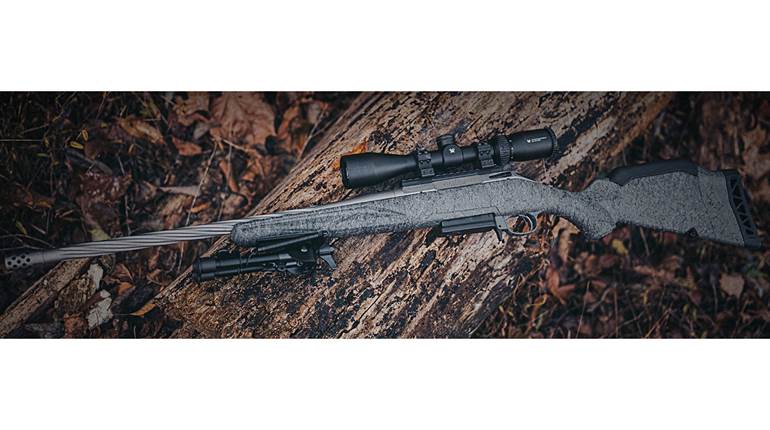
Ivan Drago, the protagonist in Rocky IV, famously said, “If he dies, he dies,” setting the stage for a classic USSR vs. USA movie plot. Released in 1985, during the Cold War, the movie tapped into the sentiments around the looming threat of military conflict between the United States and the Soviet Union. Thankfully, that fear never came to fruition, but each side was fully prepared for the event. Let’s take a look at the primary small arms cartridges for the two sides: America’s 5.56 NATO and the Soviet Union’s 5.45x39 mm.
Just as the U.S. Army downsized from the .30-’06 Sprg. to the 7.62 NATO, the next progression was a significantly smaller shoulder-fired cartridge. Giving the respect to the elder cartridge first—as well as respecting the home-field advantage—the 5.56 NATO came to light as the solution that gave the foot soldier the most amount of firepower for the least amount of weight. The list of names involved in the development of the 5.56 NATO is long and sordid, but for our purposes, I will give the general gist of things.

The U.S. Army sought a small-caliber, high-velocity cartridge (SCHV) using a .22-cal. bullet, which would maintain supersonic flight out to 500 yards, penetrate one side of a standard-issue steel helmet at 500 yards and offer a trajectory similar to the .30-’06 Sprg. out to that distance. Using Eugene Stoner’s scaled-down AR-10 rifle (soon to be known as the AR-15), it was Robert Hutton of Guns & Ammo and Frank Snow of Sierra Bullets—with the help of Remington—who finally modified a .222 Remington case to drive a 55-grain bullet to a speed sufficient to meet the prescribed parameters. Offering more consistent firing than the M14, the modified .222 Rem. cartridge would soon be renamed .223 Remington, with Big Green officially adopting the design for its sporting rifles.
 This imprint is from a 20-round box of .224E2 ammunition. The experimental Winchester .224E1 cartridge (left) and E2 cartridges (right) were early competitors of the .223 Rem./5.56x45 mm NATO cartridge that remains a U.S. military mainstay to this day.
This imprint is from a 20-round box of .224E2 ammunition. The experimental Winchester .224E1 cartridge (left) and E2 cartridges (right) were early competitors of the .223 Rem./5.56x45 mm NATO cartridge that remains a U.S. military mainstay to this day.
The .223 Rem. is a rimless case, headspacing off the 23-degree shoulder, with a casehead diameter of 0.378” and a case length of 1.76”. Overall cartridge length is 2.26”, and the cartridge uses a small rifle primer to ignite its powder charge. The round—the “Cartridge, 5.56mm Ball, M193” in military nomenclature—would use a 55-grain bullet at a muzzle velocity of 3,250 f.p.s. and would be officially adopted for use in September 1963. The 5.56 NATO designation would come later, adopted by the multi-national organization in 1980, with slight variations on bullet weight and configuration amongst the differing countries.
Dimensionally, there is no difference between the 5.56 NATO and .223 Rem. cartridges, though there are differences in the throat of the rifles of which fire them. Generally speaking, it is safe to fire .223 Rem. ammunition in a rifle chambered for the 5.56 NATO cartridge, but the reverse is not true. The bugaboo is M855 “Green Tip” ammunition, which uses a 62-grain projectile with a steel-tipped core for additional penetrating capabilities. While not technically qualifying as an armor-piercing bullet, M855 is the U.S. designation for the NATO-standardized SS109 load, and remains a popular choice among shooters to this day, though it requires a 1:7 twist rate for proper stabilization and a 5.56 NATO chamber and throat.

Turning to the Soviet’s correlative choice—the 5.45x39 mm cartridge—you will see the same type of design progression; the 7.62x39 mm cartridge and the world-famous AK-47 rifle would be shelved in favor of a small-caliber cartridge in the new AK-74 rifle. The 5.45x39 mm was designed in 1974, presumably in response to the effectiveness of the American 5.56 NATO in the Vietnam War, though its existence was not known to the West until 1980, when it was used in Afghanistan. Using a bullet diameter of 0.2215”, or 5.62 mm, the case measures 39.82 mm, or 1.568”, and the cartridge has an overall length of 57 mm, or 2.244”. It is also a rimless case design with a base diameter measuring 10.0 mm, or 0.394”, and features a 20-degree, 18-minute shoulder angle to handle the headspacing.
The Soviet military’s standard round was designated as 7N6, using a 52-grain, full-metal-jacket projectile with a steel core under a lead cover; the projectile is a boattail design with a sleek ogive and produces a muzzle velocity of 2,950 f.p.s. The 7N6 cartridge also uses a Berdan primer in a lacquered steel case. I have read reports indicating that the bullets were actually designed to be unstable, and there are recollections of wound channels to correlate that. Though that does not make much sense, to design an unstable bullet, as you’d have a tough time hitting the target. Perhaps it is better said that the rearward center of gravity may cause the projectile to flip, base forward, upon impact. The 7N6 ammo was classified as armor-piercing by the BATFE in 2014, and all subsequent imports have been banned.

Considering the importation ban stateside, U.S. companies have incorporated the 5.45x39 mm cartridge into their manufacturing rotations. Hornady, for instance, makes a 60-grain V-Max bullet and loads in its Black line for the American market, which travels at 2,810 f.p.s. and comes in Boxer-primed reloadable brass cases. While this load isn’t always available, I owe a thank you to the Lone Star Gun Range in Lumberton, Texas, for having some on hand; it is a popular choice for those who appreciate the cartridge.
Pitting the two cartridges against one another, I feel the 5.56 NATO has a number of advantages over the 5.45x39 mm. First and foremost, the varying bullet-weight choices, though one may have to handload the very light and very heavy options, in .224-caliber give the cartridge all sorts of flexibility. In addition, the availability of quality brass cases, which can certainly be reloaded, is an added bonus. As affordable as steel-cased ammo can be, it takes the possibility of reloading off the menu.

The 5.56 NATO offers better muzzle velocity over the 5.45x39 mm cartridge—3,060 f.p.s. for the 62-grain load versus 2,810 f.p.s. for the 60-grain load, respectively—which will certainly help with downrange performance. Comparing the Hornady Black ammunition at the weights and velocities stated above, the 500-yard drop will be 58.8” for the Russian cartridge and 49.7” for the American design. That test data was developed in a 20” barrel for the 5.56 NATO, while the 5.45x39 mm was tested in a 16” barrel, so you might see the gap between the two cartridges tighten if the Russian cartridge is to be fired from a rifle with a longer barrel.
What I consider to be the ultimate deciding factor between these two cartridges is the sheer availability of ammunition. Almost every reputable U.S. manufacturer of ammunition offers some form of 5.56 NATO ammo; the same cannot be said for the Russian 5.45x39 mm, so you’ll be hard-pressed to keep an AK-74 properly fed. Also, factor in choices of .223 Rem. ammunition in addition to 5.56 NATO, and the nearly innumerable components available for both iterations of the cartridge, selecting 5.56 NATO over 5.45x39 mm seems quite obvious. The 5.56 NATO has, quite assuredly, become one of America’s go-to cartridges.





































